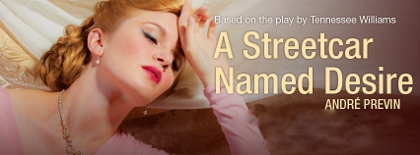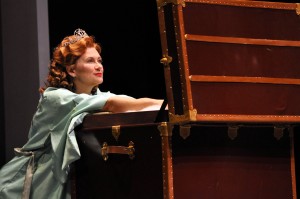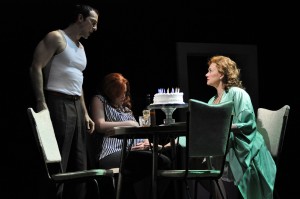NEW ORLEANS IN VIRGINIA
Like many operas in the last 100 years, Andre Previn’s A Streetcar Named Desire – recently produced by Virginia Opera – is through-composed with very little straight dialogue, declamatory vocals, and text set to music so that the words and sense are both clear (this is also known as Literaturoper). Before Debussy’s Pellas et Melisande in the early 20th century, it was rare to set a play to music without writing a libretto substantially revising the original text – Mozart’s The Marriage of Figaro is a famous example, changing the revolutionary stage play to a melodic opera of aristocratic maneuvering countered by clever servants. The late Lee Hoiby set the first Tennessee Williams play as an opera, Summer & Smoke, and that remains a great vehicle for college and grad school singers.
After years of different teams negotiating with the Tennessee Williams estate, SF Opera commissioned Composer Previn and Librettist Philip Littell to make an opera out of William’s A Streetcar Named Desire, now over sixty years old. The Williams estate set the proviso that the script be retained as far as possible and the plot not altered. Thus, both Previn and Littell had to make room for music lines that would fit the already operatic language of Streetcar’s now iconic 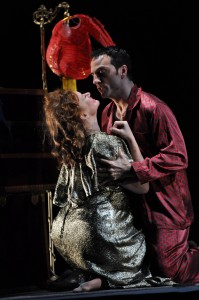 characters, the composer submitting to the verbal imagination of Williams. Anyone who comes to this opera must suspend disbelief that a musical setting would disrupt the arc of the play.
characters, the composer submitting to the verbal imagination of Williams. Anyone who comes to this opera must suspend disbelief that a musical setting would disrupt the arc of the play.
Melodic intimations and the orchestral line fill in the already strong – but necessarily highly abbreviated – language with mood and local color such that the saxophone- and trumpet-infused score subtly conveys recollection. (Matthew Ernst, principal trumpet, took a well-deserved bow at the closing curtain.) Musical motifs are presented in later contexts, such as when Blanche’s disturbed memories take over, as when Mitch’s infatuation with the exotic bloom of Blanche turns into brutalizing prejudice against her, and in Stella’s obsessive attraction to Stanley. Conductor Ari Pelto kept a free control over the syncopations and blues-like, New Orleans-flavored orchestral harmonies.
Further, whereas the play and film seem to revolve around Marlon Brando’s gripping and overwhelming Stanley, the opera focuses on Blanche DuBois, who necessarily depends on the kindness of the composer. (Renee Fleming, the first Blanche, worked with Previn in shaping the music.) Stanley doesn’t do arias; he’s too much of a “common man” for that. Mitch has lyric passages, and Scott Ramsay sang in such a nuanced and beautiful way as Stanley’s friend that he deserved the special kudos he got from the audience; he was very credible going from a star-struck and lonely man to a violent one and finally a man fully manipulated and dominated by Stanley.
The orchestral lyricism contrasts sharply with the story unfolding, softening it in comparison to the stage play. Whereas Jessica Tandy and Vivien Leigh could communicate the increasingly nervous detachment of Blanche from reality, the soprano singing Blanche must keep in strong voice throughout, and then suffer a very quick descent into madness when first confronted in the last scene of the final act with the doctor and nurse Stanley had brought in, with Stella’s acquiescence, to take Blanche to an institution.
The emphasis on communicating the natural rhythm of spoken English also means that there are very few arias, i.e., music that stands apart from its context and feels like a song, and those which exist are all very short (1-3 minutes). Vocally, the operatic Blanche begins to show herself in Act II’s high point: her courtship of Mitch after her trial seduction of the newspaper boy. Thanks to Fleming, the only two arias from the opera that have established themselves as independent concert pieces are Blanche’s “I Want Magic!” and her poignant “I Can Smell the Sea Air” at the opera’s denouement. In this production, Blanche is seldom off-stage and even when not singing, the director Sam Helfrich ensured that she is always part of the action, even if peripherally.
Here, Blanche was sung by the dramatic soprano Kelly Cae Hogan, who has sung many leading roles in Wagner operas, and thus has the power, charisma, and great acting chops to communicate Blanche’s exoticism, elegance, demons, and vulnerability. Because Blanche is the only character with good arias, it is a mark of Hogan’s great voice that she can be on stage almost the entire opera and still have enough stamina to give full and brilliant voicing to the culminating arias in Act III. She gave a well-acted performance to the last in “I Can Smell the Sea Air,” which is an understated and elegiac mad scene in which Blanche visualizes her death at sea – the ship’s kind and handsome doctor holding her hand – before her shrouded form falls back into the deep blue of her first love’s blue eyes.
As Stanley, David Adam Moore (who repeats the role in April with the Chicago Lyric Opera) refused to model his interpretation on the iconic Brandon and instead created a fully believable other character, alternatively self-confident, scheming, erotically charged; a he-man frightened at losing both Stella and control over his own home.
Previn and Littell wisely reshaped the famous scene where Stanley bellows out “Stella,” pleading for his pregnant wife to come back to his bed after he had brutally slapped her in a drunken fit. Moore did not so much shout “Stella” as bawl it from a very deep pain and remorse, lying in the front of the stage, almost in a fetal position. The scene that follows is an operatic coups de théâtre: Stella returns without a word, the orchestra suggests consuming sex, and when Blanche appears on the scene, all she can get from Stella is a beautifully simple “La, lala, lala, la-lalala-la,” which shows in plucked string bass accompaniment that she is totally in thrall to Stanley. Julia Ebner was a very believable Stella, with beautiful, lyric tones.
Later, Stanley puts on the pajamas he wore with Stella on their wedding night and moves toward Blanche, who doesn’t seriously resist. The orchestra takes over what was a scene change in the play after Blanche’s “date” with Stanley (while Stella was in the hospital giving birth). This could have been harrowing music but isn’t in Previn’s score because the focus isn’t on the rape itself but on Blanche’s psyche. Stanley had already presented Blanche with a ticket back to Mississippi, Mitch had dumped Blanche and then tried to rape her – a mere fallen and perverse woman in his eyes, and Blanche had finally come to the realization her life could not continue. The quiet music thus becomes quietly frightening because the audience is identifying with Blanche’s humiliation and loss of self.
I did not think the staging did justice to the story. The set design could have shown the claustrophobia of an essentially one-room apartment, Blanche’s sleeping area divided only by a sheet from Stanley and Stella’s bed. Scenic Designer Andromache Chalfant took another route, making the cramped apartment into a 1950s’ ranch house set, with middle class furniture from that period. This also had the unfortunate effect of confusion, because the one room in the stage play became a vast space, and the action had to be stretched out to accommodate the director’s cues. Whereas the dining room table was at the side in the first act, for the following 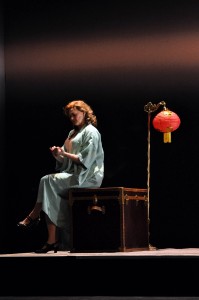 two acts it was in the center of the stage, and the sofa migrated from stage left to stage right between the first and next acts.
two acts it was in the center of the stage, and the sofa migrated from stage left to stage right between the first and next acts.
There were also a total of six doors in the set, far too many for the shotgun-style first-floor apartment in the libretto, even though it was a clever touch to have extras in the doorways used to represent some of the young men Blanche had “dated” while at Belle Reve (there were also two men who made out in one of the door frames when Blanche told of coming upon her blue-eyed young and handsome love with an older male admirer). The director Sam Helfrich kept the action moving across the vast set, and it’s unclear how much input he had in the scenic design (which of course had to be easily transportable between the three very different stages between which the Virginia Opera traveled). I thought he overplayed the entrance of the flower vendor, because she moved through the many doors and then sat on the sofa, dominating the stage in her Mexican peasant dress and deep sonority, and taking the attention away from Blanche. (That low-voiced singer, here Sondra Gelb, is usually played as a peripheral character, with her words “Flores para los muertos – flowers for the dead” getting the point of death now haunting the stage across well enough.)
This was my first exposure to the Virginia Opera; I admire its ability to take opera “on the road,” as European companies like England’s Opera North the Netherlands’ Opera Zuid, allowing far more people to see the work. The audience in Richmond, which is a very sophisticated theater town with several important live theaters (including the fabled Firehouse), was attentive and quiet, and although a small number of patrons left after each act, the audiences at the two performances that I witnessed applauded long and hard each time.
photos by David A. Beloff
A Streetcar Named Desire
Virginia Opera
Harrison Opera House in Norfolk;
GMU Center for the Arts in Fairfax;
Carpenter Theatre at Richmond CenterStage
played February 16 to March 10, 2013
visit Virginia Opera for upcoming shows
